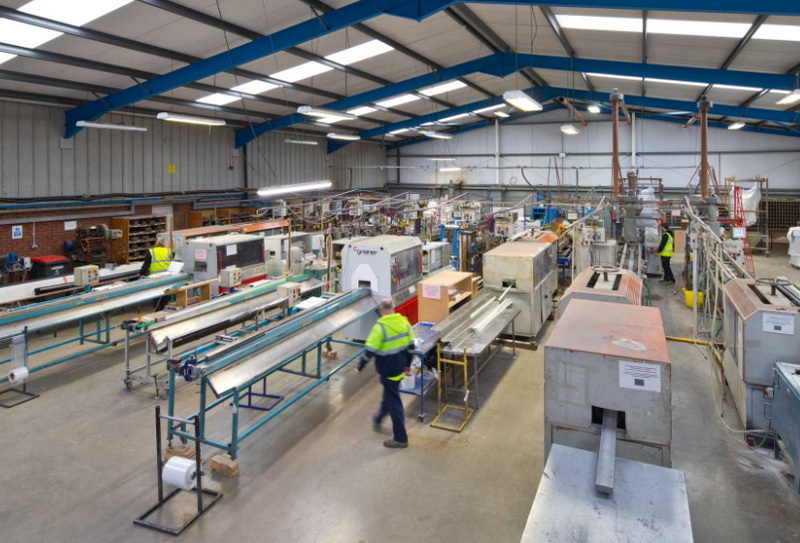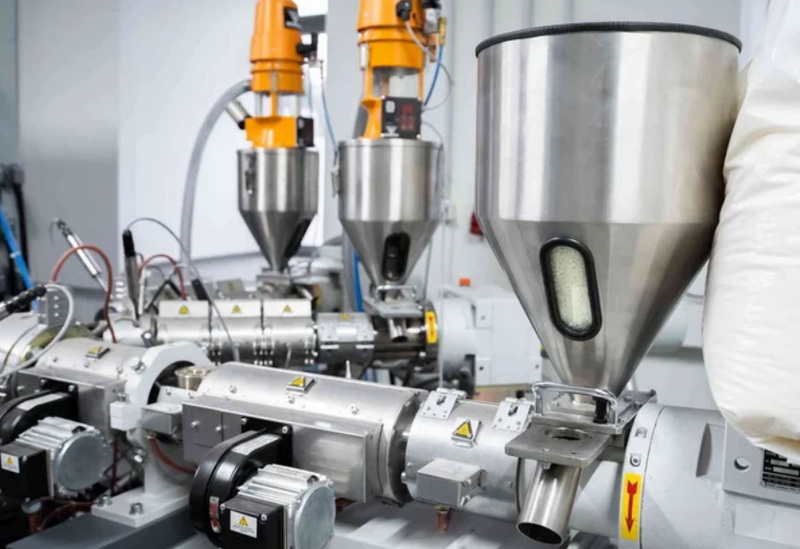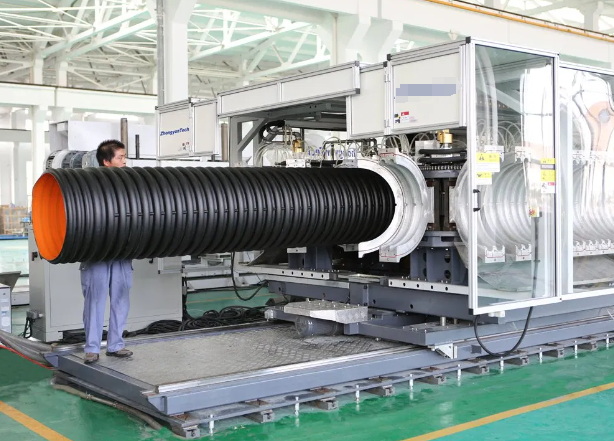Content Menu
● Understanding the Basics of Extrusion
● The Steps Involved in the Extrusion Process
● Types of Extrusion Processes
● Applications of Extrusion
>> Common Applications in Detail
● Advantages of Extrusion
● Challenges in Extrusion
● Innovations in Extrusion Technology
● Conclusion
● FAQs
>> 1. What types of materials can be extruded?
>> 2. How does temperature affect the extrusion process?
>> 3. What is the difference between hot and cold extrusion?
>> 4. Can recycled materials be used in extrusion?
>> 5. What industries utilize extrusion?
● Citations:
The extrusion production process is a widely utilized manufacturing technique that shapes materials into specific profiles by forcing them through a die. This method is applicable to a variety of materials, including metals, plastics, and even food products. In this article, we will explore the intricacies of the extrusion production process, how it works, its various applications, and the technology behind it.

Understanding the Basics of Extrusion
Extrusion is defined as a process that involves pushing material through a die to create an object with a fixed cross-sectional profile. The material can be in solid, semi-solid, or molten form, depending on the type of extrusion being performed. The key components of the extrusion process include:
- Extruder: The machine that applies heat and pressure to the material.
- Die: A specialized tool that shapes the material as it passes through.
- Cooling System: A mechanism that helps solidify the extruded material after shaping.
The Steps Involved in the Extrusion Process
The extrusion production process can be broken down into several key steps:
1. Raw Material Preparation: The process begins with selecting and preparing raw materials, which can be in the form of pellets, granules, or powders. For plastics, thermoplastic resins like polyethylene or polypropylene are commonly used.
2. Feeding: The prepared raw materials are fed into a hopper connected to the extruder. Gravity or mechanical means may assist in this process.
3. Melting: Inside the extruder, the materials are subjected to heat and mechanical shear from a rotating screw. This causes them to melt and become viscous.
4. Shaping: Once melted, the material is forced through a die that shapes it into the desired profile. The die's design is critical as it determines the final product's dimensions and characteristics.
5. Cooling: After exiting the die, the extruded material is cooled using air or water to solidify it into its final shape.
6. Cutting and Finishing: Finally, the extrudate is cut to length and may undergo additional finishing processes such as surface treatment or machining.
Types of Extrusion Processes
Different types of extrusion processes cater to various materials and applications:
- Direct Extrusion: The most common method where material is pushed through a stationary die.
- Indirect Extrusion: In this method, the die moves with the ram, allowing for more complex shapes while reducing friction.
- Cold Extrusion: Performed at or near room temperature; ideal for materials that could lose properties when heated.
- Hot Extrusion: Conducted above a material's recrystallization temperature, making it easier to shape but requiring careful temperature control.
- Hydrostatic Extrusion: Utilizes hydraulic pressure to push materials through a die without significant friction.
Applications of Extrusion
The versatility of the extrusion production process makes it suitable for numerous applications across various industries:
- Construction: Producing window frames, pipes, and other structural components.
- Automotive: Creating parts such as bumpers and trims.
- Consumer Goods: Manufacturing items like packaging films and containers.
- Food Industry: Forming products like pasta or snacks through food extrusion processes.
Common Applications in Detail
1. Construction Industry:
- Window frames and doors made from extruded aluminum or PVC provide durability and energy efficiency.
- Structural components such as beams and columns benefit from aluminum's lightweight yet strong properties.
2. Automotive Sector:
- Weather seals, gaskets, and tubing for fluid transfer systems utilize extruded plastics due to their resistance to chemicals and UV exposure.
- Lightweight components made from aluminum help improve vehicle fuel efficiency.
3. Consumer Products:
- Packaging films produced through plastic extrusion enhance shelf life while reducing waste.
- Items like straws and containers are manufactured quickly and efficiently using this method.
4. Food Processing:
- Food extrusion allows for mass production of snacks like cheese puffs and breakfast cereals by cooking ingredients under pressure while shaping them simultaneously[5][10].

Advantages of Extrusion
The extrusion production process offers several benefits:
- Efficiency: Continuous production capabilities allow for high output rates.
- Material Utilization: Minimal waste as excess material can often be recycled back into the process.
- Versatility: Ability to produce complex shapes and profiles tailored to specific applications.
Challenges in Extrusion
Despite its advantages, there are challenges associated with extrusion:
- Quality Control: Variability in temperature and pressure can lead to defects in products.
- Die Design Complexity: Designing dies for intricate shapes can be time-consuming and costly.
- Material Limitations: Not all materials are suitable for extrusion; some may require alternative manufacturing methods.
Innovations in Extrusion Technology
Recent advancements in extrusion technology have significantly improved efficiency and product quality:
1. Artificial Intelligence (AI):
- AI algorithms analyze real-time data from extrusion machinery for immediate adjustments, enhancing product quality while optimizing resource use[4][12].
2. Hybrid Techniques:
- Combining traditional methods with advanced processes allows manufacturers to create profiles with enhanced strength and formability[4].
3. Sustainability Efforts:
- Innovations focused on energy-efficient processes and recycling initiatives aim to reduce carbon footprints across industries[12][16].
4. Precision Control Systems:
- Modern extrusion lines equipped with IoT technology enable real-time monitoring of parameters like temperature and pressure[9][12].
5. Multi-layer Extrusion Technology:
- This technique allows manufacturers to create composite materials with unique properties by simultaneously pushing multiple layers through an extruder[17].
Conclusion
The extrusion production process is a fundamental manufacturing technique that plays a crucial role in producing various products across multiple industries. By understanding its workings—from raw material preparation to cooling and finishing—manufacturers can optimize their processes for efficiency and quality. As technology advances, we can expect further innovations in extrusion techniques that enhance capabilities and broaden applications.

FAQs
1. What types of materials can be extruded?
Extrusion can be performed on various materials including metals (like aluminum), plastics (such as PVC), ceramics, and even food products.
2. How does temperature affect the extrusion process?
Temperature significantly impacts viscosity; higher temperatures generally reduce viscosity making it easier for materials to flow through dies.
3. What is the difference between hot and cold extrusion?
Hot extrusion occurs above a material's recrystallization temperature while cold extrusion takes place at room temperature or slightly above it. Cold extrusion typically results in stronger products due to work hardening.
4. Can recycled materials be used in extrusion?
Yes, many extruders are designed to handle recycled materials effectively, helping reduce waste and lower production costs.
5. What industries utilize extrusion?
Extrusion is utilized in various industries including construction, automotive, consumer goods manufacturing, food processing, medical devices, and more.
Citations:
[1] https://paulmurphyplastics.com/industry-news-blog/extrusion-process-working-types-application-advantages-and-disadvantages/
[2] https://www.clarkrandp.com/6-common-applications-of-plastic-extrusion/
[3] https://www.rayda.co.uk/blog/advantages-and-disadvantages-of-plastic-extrusion/
[4] https://yamunaind.com/innovation-spotlight-recent-advancements-in-aluminium-extrusion-technology/
[5] https://en.wikipedia.org/wiki/Food_extrusion
[6] https://www.gabrian.com/what-is-aluminum-extrusion-process/
[7] https://daextrusion.com/applications/
[8] https://www.howardprecision.com/advantages-and-disadvantages-of-direct-extrusion/
[9] https://www.richardsonmetals.com/innovations-in-aluminum-extrusion-pioneering-precision-and-quality/
[10] https://www.ift.org/news-and-publications/food-technology-magazine/issues/2017/july/columns/processing-extrusion-and-applications-in-food-industry
[11] https://www.keyence.com/products/measure-sys/image-measure/resources/image-measure-resources/what-is-the-extrusion-process-types-and-advantages.jsp
[12] https://profileprecisionextrusions.com/the-evolution-of-aluminum-extrusions-emerging-trends-and-technologies/
[13] https://www.youtube.com/watch?v=CTNKNDcZ9aA
[14] https://www.tfgusa.com/understanding-extrusion-a-fundamental-manufacturing-process/
[15] https://plasticextrusiontech.net/applications/
[16] https://aec.org/features-benefits
[17] https://plasticextrusiontech.net/shaping-the-future-of-plastic-extrusion-technology/
[18] https://foodprocessing.wsu.edu/extension/training/extrusion-processing/
[19] https://onlytrainings.com/Polymer-Extrusion-Quick-Overview-Of-Extrusion-Process-and-Parameters
[20] https://www.3erp.com/blog/plastic-extrusion/
[21] https://www.alexandriaindustries.com/industry-news/overcoming-challenges-misconceptions-extrusion/
[22] https://www.petfoodprocessing.net/articles/17125-recent-advancements-edging-extrusion-tech-toward-excellence
[23] https://www.bausano.com/en/technology/food-extrusion
[24] https://study.com/academy/lesson/extrusion-definition-process-examples.html
[25] https://paulmurphyplastics.com/industry-news-blog/extrusion-process-types-advantages-disadvantages-applications/
[26] https://content.ces.ncsu.edu/extrusion-processing-a-versatile-technology-for-production-of-foods-and-feeds
[27] https://en.wikipedia.org/wiki/Extrude
[28] https://www.movacolor.com/knowledge/process/extrusion/what-is-extrusion-applications-process-steps/
[29] https://www.youtube.com/watch?v=Y75IQksBb0M
[30] https://www.dynisco.com/userfiles/files/Introduction_To_Extrusion.pdf
[31] https://midstal.com/sft1242/aluminum_extrusion_process_overview.pdf
[32] https://www.xometry.com/resources/injection-molding/injection-molding-vs.-extrusion/






















